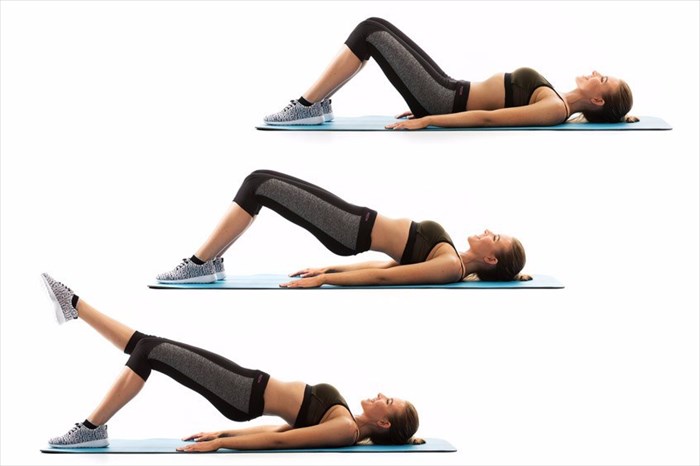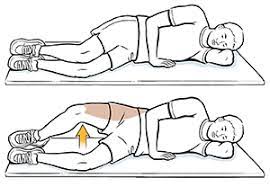
If you’ve had back surgery, it can be hard to tell how much your body has healed.
Your doctor may say you’re ready to resume normal activity, but then you go home and find that the pain is just as bad as it was before your surgery or that you still have trouble walking because of weakness in your legs.
There’s one thing you can do that will help speed up the healing process and prevent further injuries—core strengthening exercises after back surgery.
Here’s what you need to know about these exercises and how to do them correctly.
Table of Contents
The Basics of Core Strength
When you think of core strength, chances are you picture an abdominal crunch.
And while that’s certainly a type of core exercise, it isn’t really true strength—the term core actually refers to more than just your abs.
Your core also includes muscles in your back, hips, buttocks, chest (pectorals), shoulders (deltoids), neck (trapezius) and even parts of your arms (biceps).
That means developing true strength takes a lot more than crunches alone! When done correctly and consistently, core exercises can help improve balance and stability in your daily life as well as post-surgery recovery.
In fact, according to one study, improving core strength may be linked with better functioning after spinal surgery.
What Happens if You Don’t Build Strength?

Maintaining a strong core is important for your overall health, but also for recovering from back pain or surgery.
Your core muscles make up your abdomen, lower back, hips, pelvis and even buttocks. Core strength can reduce back pain by bracing your body against injury.
Consult with a doctor before beginning any exercise program following surgery or if you have an existing condition like arthritis.
Always perform exercises at your own risk and consult with a doctor first before attempting anything new that may put strain on your body.
If you do experience pain after trying out one of these exercises, stop doing it immediately! Working through excruciating pain could aggravate an existing injury.
You should only be feeling mild discomfort while performing these strengthening exercises. It’s best to start slow and work your way up as you get stronger.
Before starting any of these exercises, warm up with a light aerobic activity such as walking or biking. These workouts are designed to strengthen and stretch your core muscles in order to support proper posture and alignment.
You’ll want to repeat each workout two times per week until you feel comfortable increasing your repetitions.
8 Core Strengthening Exercises for Back Pain Relief
Lie Down & Lift

You don’t have to think too hard about why you need a strong core. Chances are, your back already has its own opinion on that subject.
One of the easiest and most effective ways to strengthen your core is with a simple exercise called the bridge. In order to do it, you lie down on your back with knees bent and feet flat on floor. Then, keeping hips level, lift up so only your shoulders and feet touch ground.
Hold for ten seconds at first, then extend it up to 30 seconds as your fitness improves. Repeat five times. Your abs will be burning in no time!
Planks

Start in the plank position, face down with your forearms and toes on the floor. Your elbows are straightforwardly under your shoulders and your forearms are looking ahead. Your head is loose and you ought to be checking the floor out.
Connect with your abdominal muscles, drawing your navel toward your spine. Keep your torso straight and unbending and your body in an orderly fashion from your ears to your toes with no listing or bowing.
This is the impartial spine position. Guarantee your shoulders are down, not crawling up toward your ears. Your heels ought to be over the chunks of your feet.
Stand firm on this foothold for 10 seconds. Delivery to floor.
After some time work up to 30, 45, or 60 seconds.
Alternating Curls

This is an exercise used in physical therapy and chiropractic practice because it focuses on back stability. To perform Alternating Curls, lay flat on your stomach with your knees bent, feet flat on the floor. Place a 5-pound weight plate or medicine ball at chest level.
While holding onto a secure object (like a table), raise both arms and legs up and down 10 times while counting silently until you’ve reached ten then release. Repeat for three sets of 10 repetitions each. If you find that 10 reps are too easy, increase your weight by 1 pound.
If they are too hard, decrease by 1 pound.
Arm Rotations
Once you’re ready, stand with your feet shoulder-width apart and hold a light weight in each hand. Arms should be by your sides, and lift one arm out to your side as if you were signaling a turn. Rotate your torso along with that arm until it is completely in front of you.
Return and repeat on other side. That’s one rep. Aim for three sets of 10 reps per day. Start slow—it can take a while to get used to using weights again after surgery. Always check with your doctor before starting any new exercise routine after back surgery.
Bridge with Leg Extensions

Bridge with Leg Extensions is a great way to strengthen your back muscles, not just your glutes. Start on all fours and then push through your heels and straighten your legs while keeping both knees bent.
Then lift one leg out to a 45-degree angle, keeping both feet on ground. Return your leg back down, then lift it up again at a 90-degree angle. Repeat with opposite leg until you’ve done 10 reps per side.
To increase intensity, repeat movement faster or hold for a longer period of time in each position before switching sides.
Side Lying Hip Abduction

This exercise can be done on a mat or right on your bedroom floor. While lying on your side, raise your top leg straight out in front of you for five seconds, then slowly lower it back down.
This is one rep. You should feel tension in your obliques during these movements, so if you feel like you are shaking instead of working hard, try squeezing a tennis ball between your knees while performing these exercises. Repeat 10 times per side.
Side Lying Leg Extension

Begin by lying on your side. Flex both feet and keep them together. Extend one leg up while extending your arms out in front of you.
Stretch as far as possible, making sure to keep both shoulders flat on the ground and knees together (or slightly apart if that’s easier). Hold for two seconds at a time and repeat 10 times. Then, switch sides and complete 10 more reps before switching back again.
This exercise can be done daily or whenever it is most convenient. It can also be performed with no weight added, but it may not provide as much benefit.
Mountain Climbers

When you’re just starting out, mountain climbers are a great exercise because they help you learn how to use your abdominal muscles as well as your arms and legs. Start in a push-up position with your hands on top of each other directly under your shoulders and both feet touching.
Contract your abs and pull one knee toward your chest, then alternate by bringing your other knee toward you. Continue alternating for 30 seconds without dropping either foot. A variation of this exercise is to lift your knees up towards your body instead of pulling them toward you.
Another option is single leg mountain climbers where you bring one knee at a time up towards your body while keeping only one foot on the ground at all times.
FAQs
Can I do squats after back surgery?
It depends on what type of surgery you have undergone. If you’ve had a lumbar discectomy, which removes herniated discs from your spine, then yes—squats are possible after surgery. However, if you’ve had back fusion surgery or spinal decompression, these can be too intense for your healing back and should be avoided for about six weeks after surgery. (And most surgeons recommend keeping weightlifting out of your routine for at least 12 weeks.) If you want to make a comeback in a safe way, stick with core-strengthening exercises such as crunches and planks—that way there’s no chance of reinjuring yourself during exercise.
Can I do crunches after back surgery?
For most patients, no. Crunches are a classic ab workout, but you should avoid them after back surgery. A crunch puts a great deal of pressure on your abdominal muscles—but for someone who has just had back surgery, that pressure is not ideal. Your abdominals will be sore and your back muscles could still be in recovery mode; adding crunches into your routine will only make matters worse. If you want to strengthen your core after back surgery, stick with moves that don’t require any real ab work (or involve less intense versions of those moves). Pilates is an excellent choice: Instead of isolating specific muscles, it focuses on strengthening and lengthening everything evenly.
Can you do yoga after back surgery?
Some back surgeries require a long period of immobilization, which makes traditional yoga poses impossible. But if you’re one of these people, don’t worry. All is not lost—there are plenty of non-traditional yoga asanas that help strengthen your core without requiring you to hold a position for more than a few seconds at a time. With guidance from an experienced instructor and adjustments from an assistant if necessary, most people can safely do these exercises at home with minimal risk of re-injury. Of course, if you’ve had lumbar spinal fusion surgery or have been told by your doctor that some poses would be problematic for you, it’s important to follow his/her instructions carefully. If in doubt, check with them before starting any exercise program after back surgery!












